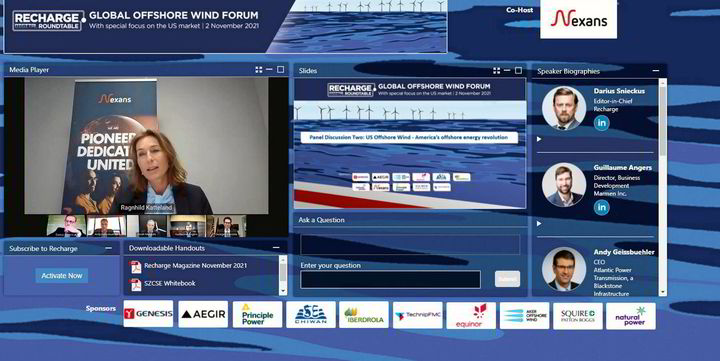Is The Future Of Offshore Wind In Jeopardy Due To Expense?

Table of Contents
The High Capital Costs of Offshore Wind Farm Development
Developing offshore wind farms requires substantial upfront investment, representing a major hurdle in expanding this vital energy source. The sheer scale of these projects and the complex technological challenges involved contribute significantly to the high offshore wind expense.
Initial Investment and Infrastructure
The initial investment in offshore wind farm development is considerable. This includes several key stages:
- Site assessment and surveys: Thorough environmental and geotechnical studies are crucial to determine the suitability of a location, adding to the overall offshore wind cost.
- Turbine manufacturing and transportation: Manufacturing massive wind turbines and transporting them to offshore locations involves significant logistical challenges and expenses.
- Substructure installation: Installing foundations, whether monopiles, jackets, or floating platforms, is a complex and expensive undertaking, especially in deeper waters. This significantly impacts the overall offshore wind expense.
- Grid connection and cabling: Connecting the offshore wind farm to the onshore electricity grid requires extensive subsea cabling and grid infrastructure upgrades, adding to the capital expenditure.
Financing Challenges and Risk Mitigation
Securing financing for these massive projects is a major challenge. The high initial investment and long development timelines increase financial risk. Mitigation strategies include:
- Government subsidies and tax incentives: Governments play a crucial role in supporting offshore wind development through financial incentives.
- Power Purchase Agreements (PPAs): PPAs guarantee a certain price for the electricity generated, reducing the risk for developers and attracting investors.
- Insurance and risk sharing mechanisms: Insurance and risk-sharing arrangements help to mitigate unforeseen issues and financial losses during development and operation.
- The role of private equity and investment funds: Private equity and investment funds are increasingly important sources of capital for large-scale offshore wind projects.
Operational and Maintenance Expenses of Offshore Wind Farms
Beyond the initial capital costs, the operational and maintenance (O&M) expenses of offshore wind farms represent a significant ongoing offshore wind expense.
Ongoing Costs of Operation and Maintenance (O&M)
Maintaining offshore wind farms requires specialized equipment and skilled personnel, leading to substantial recurring costs. These include:
- Regular inspections and repairs: Routine inspections and repairs are essential to ensure optimal performance and prevent costly breakdowns.
- Specialized vessel and crew costs for maintenance: Accessing and servicing offshore wind turbines requires specialized vessels and highly trained crews, which are expensive resources.
- Turbine component replacements: Turbine components have a limited lifespan and require periodic replacement, adding to the ongoing O&M costs.
- Environmental monitoring and impact assessments: Regular environmental monitoring is crucial to assess the impact of the wind farm on the marine ecosystem, adding to the overall expense.
The Impact of Location and Water Depth on O&M Costs
Geographical factors significantly influence O&M expenses. Deep-water locations pose several challenges:
- Accessibility challenges in deep waters: Reaching turbines in deep water is more difficult and expensive, requiring specialized vessels and equipment.
- Severe weather conditions and their impact on maintenance schedules: Harsh weather conditions can disrupt maintenance schedules, leading to delays and increased costs.
- Transportation costs and logistics: Transporting personnel, equipment, and replacement parts to remote offshore locations adds to the logistical complexity and expense.
Potential Solutions to Reduce Offshore Wind Expense
Addressing the high costs associated with offshore wind is crucial for its future. Several potential solutions can help lower the offshore wind expense and accelerate its adoption:
Technological Advancements and Innovation
Technological innovation is key to reducing costs. This includes:
- Improved turbine designs (larger, more efficient turbines): Larger, more efficient turbines can generate more power at a lower cost per unit.
- Automated maintenance and monitoring systems: Remote monitoring and automated maintenance systems can reduce the need for costly on-site inspections and repairs.
- Advances in substructure technology (floating platforms, etc.): Innovative substructure technologies can reduce installation costs, especially in deeper waters.
Streamlined Regulatory Processes and Permitting
Efficient permitting and regulatory frameworks are essential to reduce delays and costs. This involves:
- Faster approvals and streamlined permitting processes: Reducing bureaucratic hurdles and speeding up the approval process can significantly reduce project timelines and costs.
- Reduced bureaucratic hurdles and delays: Clearer regulations and simplified permitting processes can reduce uncertainty and delays.
- Collaboration between government agencies and stakeholders: Effective collaboration between government agencies, developers, and other stakeholders can streamline the permitting process.
Economies of Scale and Standardization
Large-scale projects and standardized components can significantly reduce costs through:
- Mass production of components: Mass production of standardized components can lead to significant cost reductions.
- Standardized designs and construction methods: Using standardized designs and construction methods can improve efficiency and reduce costs.
- Improved project management and logistics: Efficient project management and logistics can optimize resource allocation and reduce overall costs.
Conclusion: The Future of Offshore Wind and Addressing Expense Concerns
The high capital and operational costs, along with financing challenges, represent significant hurdles for the offshore wind industry. However, the potential of offshore wind energy to mitigate climate change remains undeniable. By focusing on technological advancements, streamlining regulations, and leveraging economies of scale, we can significantly reduce offshore wind expense. Further investment in research and development, coupled with collaborative efforts between policymakers and investors, is crucial to overcome these challenges and unlock the full potential of this crucial renewable energy source. The future of offshore wind is bright, but only if we proactively address the issue of expense and make this vital technology more accessible and affordable for a sustainable energy future.

Featured Posts
-
 Canelo Vs Plant May 6th Surace Vs Munguia 2 Adds To The Excitement
May 04, 2025
Canelo Vs Plant May 6th Surace Vs Munguia 2 Adds To The Excitement
May 04, 2025 -
 Fleetwood Macs Chart Success Continues With New Album Release
May 04, 2025
Fleetwood Macs Chart Success Continues With New Album Release
May 04, 2025 -
 Bryce Mitchell Calls Out Jean Silva For Profanity At Ufc 314 Press Conference
May 04, 2025
Bryce Mitchell Calls Out Jean Silva For Profanity At Ufc 314 Press Conference
May 04, 2025 -
 Nhl Playoffs 2024 Who Will Win The Stanley Cup
May 04, 2025
Nhl Playoffs 2024 Who Will Win The Stanley Cup
May 04, 2025 -
 Your Guide To The Ufc In May 2025 Ufc 315 And More
May 04, 2025
Your Guide To The Ufc In May 2025 Ufc 315 And More
May 04, 2025
